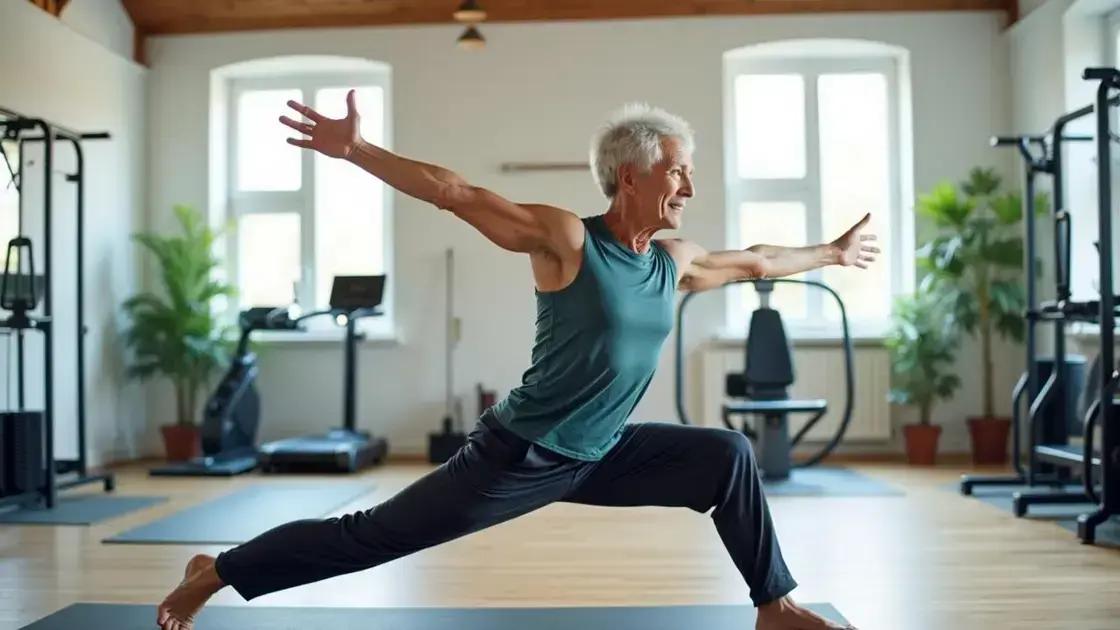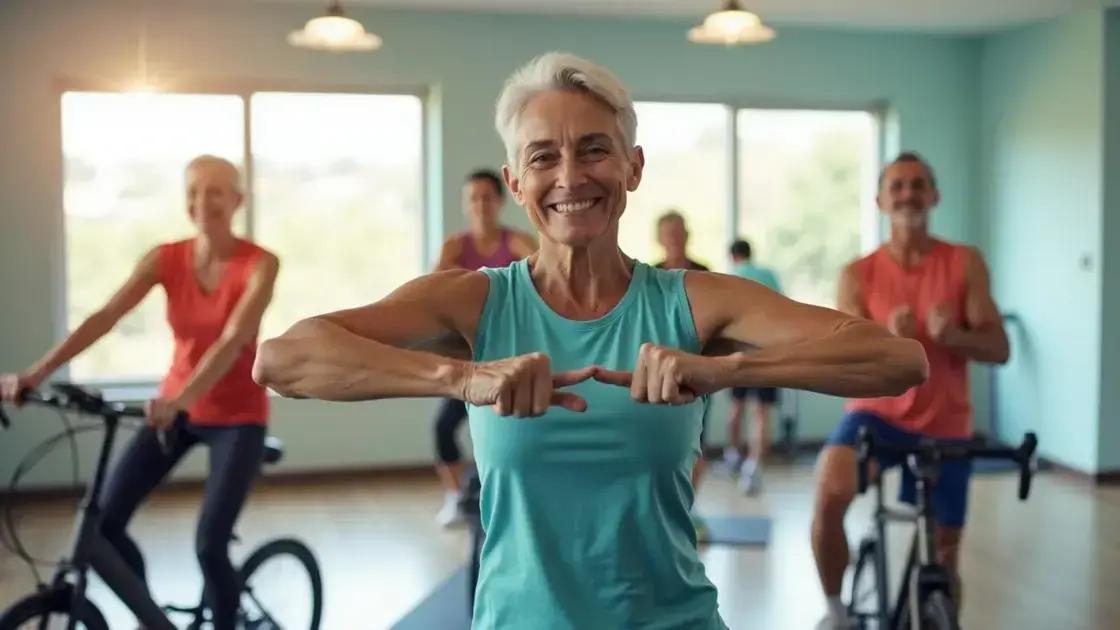Training smarter, not harder after 50 involves understanding the need for tailored workouts, incorporating strength training, cardio, flexibility, and balance exercises, and maintaining proper nutrition and hydration for optimal health and performance.
As we age, the approach to fitness must evolve. Training smarter, not harder, becomes crucial after 50 for maintaining health and vitality. Many may wonder how to adapt their routines effectively without risking injury or burnout. In this article, we will delve into essential strategies that promote safer, more effective workouts tailored for those over 50. From understanding the necessity of smarter training to curating a balanced workout routine, let’s explore how to stay fit and energetic in your later years.
Understanding the Need for Smarter Training

As we age, our bodies require a different approach to fitness. Understanding the need for smarter training is essential for maximizing health and performance after 50. Traditional workout methods that worked in our younger years may not be suitable now. Instead, it’s crucial to focus on efficiency and safety.
Adapting Your Approach
After 50, the body undergoes several changes, including reduced muscle mass and strength. Therefore, shifting to a training method that minimizes injury risk while still improving strength and agility is vital. Smarter training emphasizes quality over quantity, allowing for better recovery and sustainable progression.
The Role of Recovery
Another critical aspect of smart training is understanding recovery. Older adults often need more time to recover from workouts. Incorporating rest days and lighter workout sessions into your routine can enhance overall results and prevent burnout. Listening to your body and adjusting as needed is key.
Setting Realistic Goals
Setting realistic fitness goals is also a core component of smarter training. Instead of aiming for extreme changes, focus on achievable steps. This can include enhancing flexibility, improving balance, or gradually increasing strength. Smaller, consistent efforts build lasting habits and contribute to long-term success.
Preventing Injury
Injury prevention is paramount in any exercise routine, especially for those over 50. Engaging in activities that promote joint health, such as swimming or cycling, alongside strength training can aid in preventing injuries. Encourage a mix of different forms of exercise to maintain overall body strength without overloading specific areas.
Top Exercises for Those Over 50

Finding the right exercises is key for those over 50. The goal is to keep the body active while ensuring safety and effectiveness. Some of the top exercises for those over 50 focus on strength, flexibility, balance, and endurance.
Strength Training
Strength training is essential to fight muscle loss. Simple bodyweight exercises like push-ups, bodyweight squats, and lunges are fantastic for building strength. Resistance bands are also great as they are gentle on the joints while providing effective resistance.
Flexibility Exercises
Flexibility is vital for overall mobility. Performing yoga or stretching exercises can improve range of motion and help prevent injuries. Focus on stretches that target key muscle groups such as the back, legs, and shoulders.
Balance Workouts
Balance becomes crucial as we age to prevent falls. Exercises like tai chi and standing on one leg can greatly improve stability and coordination. These exercises can help enhance reaction times to unexpected situations.
Cardiovascular Activities
Cardiovascular health is important at any age. Engaging in walking, cycling, or swimming provides excellent cardio benefits. Aim for at least 150 minutes of moderate-intensity activity each week. Utilizing these activities not only boosts your heart health but also increases your endurance.
Nutrition Tips for Training Success

Nutrition plays a critical role in training success, especially after 50. Proper fuel helps enhance performance, recovery, and overall health. Here are some essential nutrition tips for training success:
Eat a Balanced Diet
Consuming a variety of foods ensures you get all the necessary nutrients. A balanced diet should include plenty of fruits, vegetables, whole grains, and lean proteins. This combination helps provide energy and supports muscle maintenance.
Focus on Protein
Protein is vital for muscle repair and growth. Aim for high-quality protein sources like chicken, fish, beans, and Greek yogurt. Eating protein throughout the day helps maintain muscle mass, especially when paired with strength training.
Stay Hydrated
Hydration is essential for optimal performance. Drink water regularly, especially before, during, and after workouts. Consider adding electrolyte-rich beverages if doing intense exercise, as they help replenish lost minerals.
Manage Portions
As metabolism slows with age, managing portion sizes becomes important. Eating smaller, more frequent meals can help control caloric intake while providing constant energy. This can be useful for preventing weight gain and maintaining healthy energy levels.
Plan Meals Around Workouts
Timing meals around workouts can enhance performance. Try to eat a balanced meal 2-3 hours before exercising. After workouts, a protein-rich snack or meal can help speed up recovery and refuel the body.
Creating a Balanced Workout Routine

Creating a balanced workout routine is vital for individuals over 50. A well-rounded approach helps improve overall fitness while considering safety and enjoyment. Here are some essential aspects of creating a balanced workout routine:
Incorporate Different Types of Exercise
Your workout should include a blend of strength training, cardiovascular activities, flexibility, and balance exercises. Each type of exercise plays a unique role in enhancing fitness. Strength training helps build muscle, while cardio boosts heart health. Flexibility exercises promote mobility, and balance workouts help prevent falls.
Set a Weekly Schedule
Establishing a consistent weekly schedule can improve adherence and effectiveness. Aim for at least 150 minutes of moderate-intensity aerobic activity each week, along with two days of strength training. This can be broken down into shorter sessions throughout the week to make it more manageable.
Listen to Your Body
Paying attention to how your body responds is crucial when creating a workout routine. If you experience pain or fatigue, don’t hesitate to modify your plan. It’s important to allow for rest days and adjust the intensity based on your energy levels.
Mix Up Your Routine
To prevent boredom and maintain motivation, consider varying your workout activities. Try different classes, such as dance, yoga, or swimming, to keep things fresh. Mixing up your exercises also helps work different muscle groups and can improve overall fitness.
Include Warm-Up and Cool Down
Starting each session with a proper warm-up and ending with a cool-down is essential. A 5-10 minute warm-up prepares the body for exercise, reducing the risk of injury. Similarly, cooling down helps lower heart rates gradually and can enhance recovery.
Embracing Smarter Training After 50
Training smarter, not harder, after 50 can redefine how you achieve fitness goals. By focusing on understanding the need for smarter training, incorporating effective exercises, maintaining proper nutrition, and creating a balanced workout routine, you lay the foundation for long-term health and vitality.
Adapting your routines to include a variety of activities, listening to your body, and ensuring you nourish it properly will contribute to a healthier lifestyle. Remember, it’s not just about working out; it’s about creating a sustainable fitness plan that enhances your quality of life.
By embracing these strategies, you can enjoy the benefits of an active lifestyle well into your later years, empowering yourself to live life to the fullest.
FAQ – Frequently Asked Questions about Training Smarter After 50
What are the benefits of training smarter, not harder after 50?
Training smarter focuses on efficiency and safety, helping to maintain health, prevent injuries, and improve overall fitness.
What types of exercises should I include in my routine?
Incorporate a mix of strength training, cardiovascular activities, flexibility exercises, and balance workouts to create a balanced fitness routine.
How can nutrition impact my training success?
Proper nutrition fuels the body, enhances recovery, and supports muscle maintenance, making it crucial for achieving training goals.
Why is hydration important for older adults?
Staying hydrated supports overall health, improves physical performance, and helps in recovery during workouts.
How do I ensure my workout routine is balanced?
Include various types of exercises, set a consistent schedule, listen to your body, and prioritize warm-up and cool-down sessions.
What should I consider when planning my meals around workouts?
Aim to eat a balanced meal 2-3 hours before exercising and consume a protein-rich snack afterward for optimal recovery.












